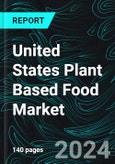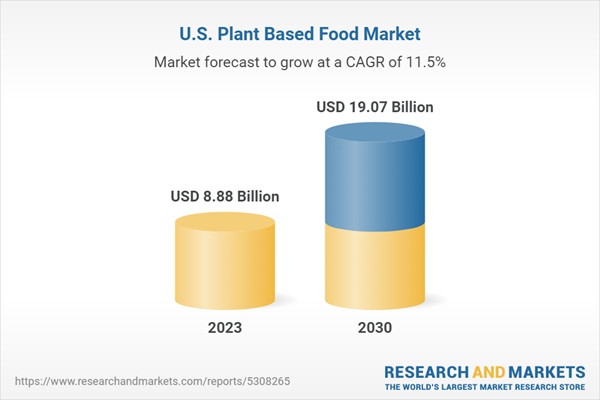The plant-based food market in the United States is predicted to grow steadily because of the growing demand for nutritious and eco-friendly options. Many companies have recounted this demand and are introducing plant-based meals items with clean labels and plant-based components. However, the increasing cost of plant based food may additionally avoid growth, especially in countries with low consumer per capita income.
The reputation of plant-based products is on the upward thrust, and it is a trend that is in all likelihood to continue within the United States. With its numerous benefits, along with environmental sustainability and dietary value, this meals choice is increasingly turning attractive to customers.
United States plant-based food market is predicted to grow at a CAGR of 11.54% between 2024 and 2030
The US plant based food industry has visible an upward thrust in recent decade due to consumer' growing awareness on decreasing animal product intake. Plant-based meat is gaining more significance, specifically in the context of vegan diets, which involve avoiding animal based foods altogether. People adopt this way of life for numerous motives, consisting of fitness and ethical issues, promoting sustainability, and preventing animal cruelty in their food and beverages. The market for plant based food is rising, pushed by factors like health concerns, environmental focus, and changing consumer possibilities. The trend towards plant based diets and alternative proteins have been gaining momentum within the United States, and the market is expected to develop even more in the coming years.The food market is currently experiencing a surge in preference for plant-based diets, along with vegetarian, vegan, and flexitarian, fueled by rising health cognizance and interest in sustainable meal alternatives. According to Amy's Kitchen in April 2023 confirmed that 52% of Americans expressed an interest in vegan food. The US plant-based food market became valued at US$ 8.88 Billion in 2023.
Meat alternatives will represent maximum share in the plant-based food market in the United States
By Segments, The United States Plant-Based Food Market is segmented into Milk, Meat, Meals, Ice Cream, Yogurt, Creamer, Butter, Cheese, Tofu and Tempeh, Ready to drink Beverages, Condiments, Dressings, and Mayo, Spreads, Dips, Sour Cream and Sauces, Eggs, and Others. The plant-based meat industry inside the US is anticipated to increase appreciably because of the rising reputation of vegetarian and vegan diets. Soy based meat alternatives are becoming increasingly renowned because of their meat-like texture and flavors. Brands and startups inside the US are introducing soy-based products to cater to the developing demand, driven through consumer' desire for allergen-loose ingredients, health interest, sustainability problems, and advanced taste and availability of plant-based products in grocery stores.Lion’s revenue share in the United States plant-based food market is held by Quick Service Restaurants (QSR)
The US plant based food market is segmented into various categories: quick-provider eating places (QSR), full-provider restaurants, education, healthcare, lodging/casinos, recreation, commercial enterprise and industry, and others. The QSR industry in the US is booming, thanks to the factor including fast urbanization, growing disposable income, and advancement in flavors and capabilities. There has been an extensive growth inside the popularity of plant based meat, with several fast food chains globally leaping on the trend. KFC, for instance, has become the first fast food chain to introduce a plant based chicken product to its menu. In January 2022, KFC delivered Beyond Fried Chicken nuggets made from plant-based meat to its menu in the US, marking a substantial milestone within the food market journey towards sustainable and ethical meals manufacturing.Key Players
Some of the predominant companies in the Plant-Based Food Market of the US are Beyond Meat Inc., Conagra Brands, Maple Leaf Food Inc., Archer Daniels Midland, US Foods Holding Corp, Kellanova, Tyson Foods, and Hormel Foods Corporation.Segments - Market breakup from 14 Viewpoints
- Milk
- Meat
- Meals
- Ice Cream
- Yogurt
- Creamer
- Butter
- Cheese
- Tofu and Tempeh
- Ready to Drink Beverages
- Condiments, Dressings and Mayo
- Spreads, Dips, Sour Cream and Sauces
- Eggs
- Others
Food Services - Market breakup from 8 Viewpoints
- Quick Service Restaurants (QSR)
- Full Service Restaurants
- Education
- Healthcare
- Lodging/Casino
- Recreation
- Business and Industry
- Others
Merger and Acquisitions
All companies have been covered from 3 Viewpoints
- Overviews
- Recent Developments
- Revenues
Company Analysis - Market breakup from 8 Viewpoint
- Beyond Meat Inc.
- Conagra Brands
- Maple Leaf Food Inc.
- Archer Daniels Midland
- US Foods Holding Corp
- Kellanova
- Tyson Foods
- Hormel Foods Corporation
Table of Contents
Companies Mentioned
- Beyond Meat Inc.
- Conagra Brands
- Maple Leaf Food Inc.
- Archer Daniels Midland
- US Foods Holding Corp
- Kellanova
- Tyson Foods
- Hormel Foods Corporation
Methodology
In this report, for analyzing the future trends for the studied market during the forecast period, the publisher has incorporated rigorous statistical and econometric methods, further scrutinized by secondary, primary sources and by in-house experts, supported through their extensive data intelligence repository. The market is studied holistically from both demand and supply-side perspectives. This is carried out to analyze both end-user and producer behavior patterns, in the review period, which affects price, demand and consumption trends. As the study demands to analyze the long-term nature of the market, the identification of factors influencing the market is based on the fundamentality of the study market.
Through secondary and primary researches, which largely include interviews with industry participants, reliable statistics, and regional intelligence, are identified and are transformed to quantitative data through data extraction, and further applied for inferential purposes. The publisher's in-house industry experts play an instrumental role in designing analytic tools and models, tailored to the requirements of a particular industry segment. These analytical tools and models sanitize the data & statistics and enhance the accuracy of their recommendations and advice.
Primary Research
The primary purpose of this phase is to extract qualitative information regarding the market from the key industry leaders. The primary research efforts include reaching out to participants through mail, tele-conversations, referrals, professional networks, and face-to-face interactions. The publisher also established professional corporate relations with various companies that allow us greater flexibility for reaching out to industry participants and commentators for interviews and discussions, fulfilling the following functions:
- Validates and improves the data quality and strengthens research proceeds
- Further develop the analyst team’s market understanding and expertise
- Supplies authentic information about market size, share, growth, and forecast
The researcher's primary research interview and discussion panels are typically composed of the most experienced industry members. These participants include, however, are not limited to:
- Chief executives and VPs of leading corporations specific to the industry
- Product and sales managers or country heads; channel partners and top level distributors; banking, investment, and valuation experts
- Key opinion leaders (KOLs)
Secondary Research
The publisher refers to a broad array of industry sources for their secondary research, which typically includes, however, is not limited to:
- Company SEC filings, annual reports, company websites, broker & financial reports, and investor presentations for competitive scenario and shape of the industry
- Patent and regulatory databases for understanding of technical & legal developments
- Scientific and technical writings for product information and related preemptions
- Regional government and statistical databases for macro analysis
- Authentic new articles, webcasts, and other related releases for market evaluation
- Internal and external proprietary databases, key market indicators, and relevant press releases for market estimates and forecasts

LOADING...
Table Information
| Report Attribute | Details |
|---|---|
| No. of Pages | 140 |
| Published | January 2024 |
| Forecast Period | 2023 - 2030 |
| Estimated Market Value ( USD | $ 8.88 Billion |
| Forecasted Market Value ( USD | $ 19.07 Billion |
| Compound Annual Growth Rate | 11.5% |
| Regions Covered | United States |
| No. of Companies Mentioned | 8 |









